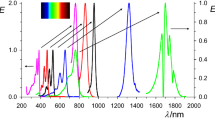Abstract
IT has been shown1 that bi-radical molecular compounds can be formed from quinones (O—Q—O) and aromatic diamines (D), and that these compounds are of the ionic form O—Q—O] D+.
Similar content being viewed by others
References
Kainer, H., Bijl, D., and Rose-Innes, A. C., Naturwiss., 13, 303 (1954).
Sidgwick, N. V., “Organic Chemistry of Nitrogen”, 97 (Clarendon Press, Oxford, 1950).
Torrey, H. A., and Hunter, W. H., J. Amer. Chem. Soc., 34, 702 (1912).
Bleaney, B., and Stevens, K. W. H., “Rep. Prog. Physics”, 16, 108 (1953).
Author information
Authors and Affiliations
Rights and permissions
About this article
Cite this article
KAINER, H., BIJL, D. & ROSE-INNES, A. Free Radical Salts of Halogenated Quinones. Nature 178, 1462–1463 (1956). https://doi.org/10.1038/1781462b0
Issue Date:
DOI: https://doi.org/10.1038/1781462b0
- Springer Nature Limited




